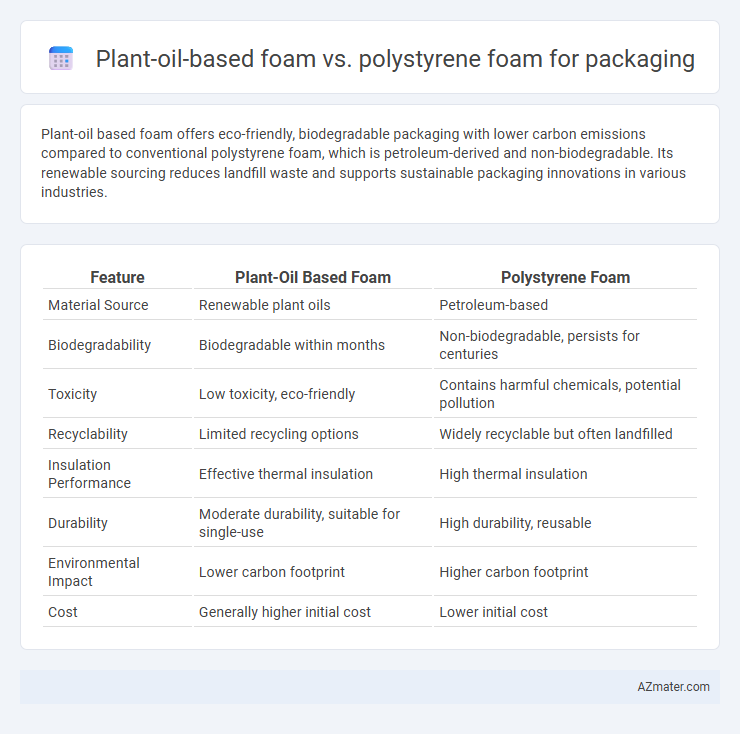Plant-oil based foam offers eco-friendly, biodegradable packaging with lower carbon emissions compared to conventional polystyrene foam, which is petroleum-derived and non-biodegradable. Its renewable sourcing reduces landfill waste and supports sustainable packaging innovations in various industries.
Table of Comparison
| Feature | Plant-Oil Based Foam | Polystyrene Foam |
|---|---|---|
| Material Source | Renewable plant oils | Petroleum-based |
| Biodegradability | Biodegradable within months | Non-biodegradable, persists for centuries |
| Toxicity | Low toxicity, eco-friendly | Contains harmful chemicals, potential pollution |
| Recyclability | Limited recycling options | Widely recyclable but often landfilled |
| Insulation Performance | Effective thermal insulation | High thermal insulation |
| Durability | Moderate durability, suitable for single-use | High durability, reusable |
| Environmental Impact | Lower carbon footprint | Higher carbon footprint |
| Cost | Generally higher initial cost | Lower initial cost |
Introduction to Plant-Oil Based and Polystyrene Foams
Plant-oil based foam, derived from renewable resources such as soybean, castor, or palm oil, offers biodegradable and eco-friendly alternatives to traditional packaging materials. Polystyrene foam, a petroleum-based synthetic polymer, is widely used for packaging due to its lightweight and insulating properties but poses environmental challenges due to its non-biodegradability and difficulty in recycling. Comparing both foams highlights the shift towards sustainable packaging solutions aiming to reduce plastic waste and carbon footprint.
Environmental Impact: Biodegradability and Sustainability
Plant-oil based foams offer significant environmental benefits over polystyrene foam due to their biodegradability and renewable resource base, reducing long-term pollution and dependence on fossil fuels. Unlike polystyrene, which can persist in landfills for hundreds of years and release toxic chemicals during decomposition, plant-oil foams typically break down more rapidly and safely in natural environments. Sustainable sourcing of plant oils supports lower carbon emissions and promotes a circular economy by integrating biodegradable packaging materials into waste management systems.
Raw Material Sources and Availability
Plant-oil based foam derives from renewable resources such as soybeans, castor beans, or corn oil, offering a sustainable alternative to polystyrene foam, which is produced from non-renewable petroleum-based styrene monomers. The availability of plant oils varies regionally and seasonally but benefits from agricultural scalability and biodegradability, while polystyrene relies heavily on fossil fuel extraction, subject to volatile market fluctuations. Growing demand for eco-friendly packaging drives innovation in plant-oil foam production, increasing raw material accessibility compared to the finite and environmentally taxing petroleum supply chain.
Production Processes and Energy Consumption
Plant-oil based foam production utilizes renewable bio-based materials such as soy or castor oil, incorporating greener chemical reactions that reduce reliance on fossil fuels, while polystyrene foam manufacturing depends heavily on petroleum-derived styrene monomers and energy-intensive polymerization processes. Energy consumption for plant-oil foams is typically lower due to milder reaction conditions and less complex refining stages, contrasting with the high-temperature, high-pressure environments required in polystyrene foam production. These differences contribute to a significantly smaller carbon footprint and improved sustainability profile for plant-oil based foams in packaging applications.
Physical and Mechanical Properties Comparison
Plant-oil based foam exhibits superior biodegradability and lower density compared to traditional polystyrene foam, enhancing its environmental sustainability while maintaining adequate cushioning performance. Mechanical properties such as compressive strength and impact resistance in plant-oil based foam are comparable to polystyrene, ensuring effective protection for packaged goods during transit. Thermal insulation properties remain efficient in both materials, but plant-oil based foam offers improved flexibility and resilience, reducing the risk of material degradation under varying temperature conditions.
Packaging Performance and Durability
Plant-oil based foam offers superior biodegradability and resistance to chemical degradation compared to traditional polystyrene foam, enhancing eco-friendly packaging performance while maintaining structural integrity. Polystyrene foam excels in shock absorption and lightweight cushioning but tends to degrade under prolonged UV exposure, compromising long-term durability. The plant-oil foam's enhanced moisture resistance and thermal stability make it a sustainable alternative for packaging applications requiring reliable protection and extended lifespan.
Cost Analysis: Economics of Foam Packaging
Plant-oil based foam typically incurs higher upfront production costs due to raw material expenses and emerging manufacturing technologies, whereas polystyrene foam benefits from established, low-cost mass production methods. Lifecycle cost analysis reveals that plant-oil foams may offer long-term economic advantages through biodegradability and reduced environmental compliance fees, contrasting with polystyrene's costly waste management and environmental impact penalties. Cost efficiency in foam packaging ultimately depends on balancing initial investment against sustainability-driven market demand and regulatory considerations.
Health and Safety Considerations
Plant-oil based foam offers a significant health advantage over polystyrene foam by being free from toxic chemicals like styrene and benzene, which are known carcinogens commonly found in polystyrene. Its biodegradable nature reduces environmental pollutants and minimizes exposure to harmful microplastics during disposal, enhancing overall safety in both usage and waste management. Furthermore, plant-oil foams typically emit fewer volatile organic compounds (VOCs), lowering risks of respiratory irritation and allergic reactions in consumers and workers handling packaging materials.
Regulatory and Market Trends
Plant-oil based foam packaging aligns with increasing global regulatory mandates targeting the reduction of single-use plastics and promoting biodegradable materials, particularly under policies like the EU's Single-Use Plastics Directive. Market trends reveal a growing consumer preference for sustainable packaging solutions, driving demand for plant-derived alternatives that comply with stricter environmental regulations in North America, Europe, and parts of Asia. Polystyrene foam faces mounting restrictions and bans due to its environmental persistence and poor recyclability, pressuring manufacturers to shift towards renewable, plant-based foams that offer a lower carbon footprint and improved end-of-life options.
Future Prospects and Innovations in Foam Packaging
Plant-oil based foam presents significant future prospects in packaging due to its biodegradability and reduced reliance on fossil fuels, aligning with global sustainability goals. Innovations in enhancing the mechanical strength and thermal insulation properties of bio-based foams are accelerating, making them competitive alternatives to traditional polystyrene foam. Advances in bio-polymer blends and enzymatic processing techniques further extend the potential for scalable, eco-friendly packaging solutions with lower environmental impact.

Infographic: Plant-oil based foam vs Polystyrene foam for Packaging
 azmater.com
azmater.com